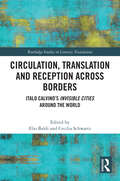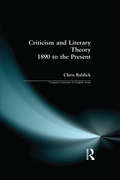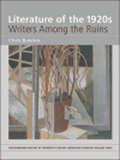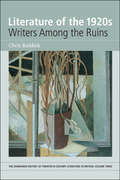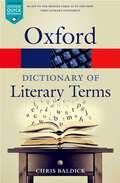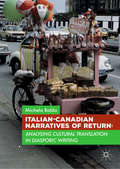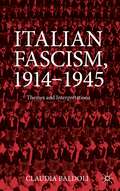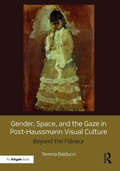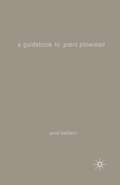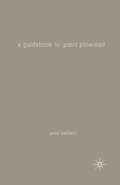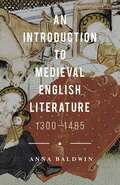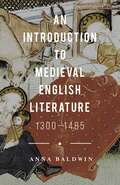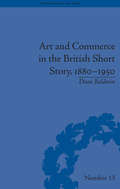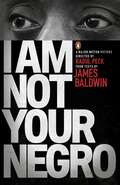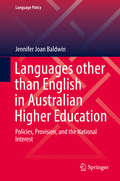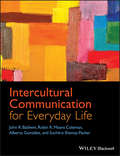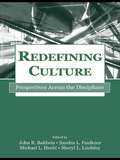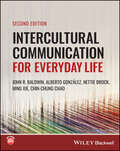- Table View
- List View
Circulation, Translation and Reception Across Borders: Italo Calvino’s Invisible Cities Around the World (Routledge Studies in Literary Translation)
by Elio Baldi Cecilia SchwartzThis volume offers a detailed analysis of selected cases in the reception, translation and artistic reinterpretation of Italo Calvino's Invisible Cities (1972) around the world. The book traces the many different ways in which Calvino's modern classic has been read, translated and adapted in Brazil, France, the Netherlands and Flanders, Mexico, Romania, Scandinavia, the USSR, China, Poland, Japan and Australia. It also offers analyses of the relation between Calvino's book and, respectively, the East and Africa, as well as reflections on the book's inspiration for, and resonance in, dance, architecture and art. The volume thus traces the diversity in the reception and circulation of Invisible Cities in different countries and continents, offering a much wider framework for the discussion of Calvino’s masterpiece than before, and a more detailed picture of its cultural and linguistic ramifications. This book will be of interest to scholars in Comparative Literature, World Literature, Translation Studies, Italian Studies, Romance Languages, European Studies, Dance, Architecture and Media Studies, as well as to scholars specialised in paratext and reception.
Circulation, Translation and Reception Across Borders: Italo Calvino’s Invisible Cities Around the World (Routledge Studies in Literary Translation)
by Elio Baldi Cecilia SchwartzThis volume offers a detailed analysis of selected cases in the reception, translation and artistic reinterpretation of Italo Calvino's Invisible Cities (1972) around the world. The book traces the many different ways in which Calvino's modern classic has been read, translated and adapted in Brazil, France, the Netherlands and Flanders, Mexico, Romania, Scandinavia, the USSR, China, Poland, Japan and Australia. It also offers analyses of the relation between Calvino's book and, respectively, the East and Africa, as well as reflections on the book's inspiration for, and resonance in, dance, architecture and art. The volume thus traces the diversity in the reception and circulation of Invisible Cities in different countries and continents, offering a much wider framework for the discussion of Calvino’s masterpiece than before, and a more detailed picture of its cultural and linguistic ramifications. This book will be of interest to scholars in Comparative Literature, World Literature, Translation Studies, Italian Studies, Romance Languages, European Studies, Dance, Architecture and Media Studies, as well as to scholars specialised in paratext and reception.
Criticism and Literary Theory 1890 to the Present (Longman Literature In English Series)
by Chris BaldickPresents a coherent and accessible historical account of the major phases of British and American Twentieth-century criticism, from 'decadent' aestheticism to feminist, decontsructonist and post-colonial theories. Special attention is given to new perspectives on Shakesperean criticism, theories of the novel and models of the literary canon. The book will help to define and account for the major developments in literary criticism during this century exploring the full diversity of critical work from major critics such as T S Eliot and F R Leavis to minor but fascinating figures and critical schools. Unlike most guides to modern literary theory, its focus is firmly on developments within the English speaking world.
Criticism and Literary Theory 1890 to the Present (Longman Literature In English Series)
by Chris BaldickPresents a coherent and accessible historical account of the major phases of British and American Twentieth-century criticism, from 'decadent' aestheticism to feminist, decontsructonist and post-colonial theories. Special attention is given to new perspectives on Shakesperean criticism, theories of the novel and models of the literary canon. The book will help to define and account for the major developments in literary criticism during this century exploring the full diversity of critical work from major critics such as T S Eliot and F R Leavis to minor but fascinating figures and critical schools. Unlike most guides to modern literary theory, its focus is firmly on developments within the English speaking world.
Literature of the 1920s: Volume 3
by Chris BaldickEclipsed until now by the dominant story of Modernism, a much more inclusive range of 1920s literature emerges freshly illuminated in Chris Baldick’s approachable history. The Twenties are reclaimed here as a period with its own distinctive historical awareness and creative agenda, one in which Modernist and non-Modernist currents are shown to engage with common memories and preoccupations. Spanning many genres high and low, including war memoirs, critical essays and detective stories as well as drama, poetry and the novel, Baldick's account situates leading works and authors of the decade – Eliot, Woolf, Lawrence, Huxley, Coward and others - among a rich array of their lesser-known contemporaries to discover common obsessions - especially with the now ‘lost’ world of pre-War Britain - and shared moods of elegiac despair, nervous frivolity and bold irreverence.
Literature of the 1920s: Volume 3 (The Edinburgh History of Twentieth-Century Literature in Britain)
by Chris BaldickThe first general account of Twenties literature in Britain
The Oxford Dictionary of Literary Terms (Oxford Quick Reference)
by Chris BaldickThe bestselling Oxford Dictionary of Literary Terms provides clear and concise definitions of the most troublesome literary terms, from abjection to zeugma. It is an essential reference tool for students of literature in any language. Now expanded and in its fourth edition, it includes increased coverage of new terms from modern critical and theoretical movements, such as feminism, schools of American poetry, Spanish verse forms, life writing, and crime fiction. It includes extensive coverage of traditional drama, versification, rhetoric, and literary history, as well as updated and extended advice on recommended further reading and a pronunciation guide to more than 200 terms. Completely revised and updated, this edition also features brand-new entries on terms such as distant reading, graphic novels, middle generation, and misery memoir. Many new bibliographies have been added to entries and recommended web links are available via a companion website.
Italian-Canadian Narratives of Return: Analysing Cultural Translation in Diasporic Writing
by Michela BaldoThis book examines the concept of translation as a return to origins and as restitution of lost narratives, and is based on the idea of diaspora as a term that depicts the longing to return home and the imaginary reconstructions and reconstitutions of home by migrants and translators. The author analyses a corpus made up of novels and a memoir by Italian-Canadian writers Mary Melfi, Nino Ricci and Frank Paci, examining the theme of return both within the writing itself and also in the discourse surrounding the translations of these works into Italian. These ‘reconstructions’ are analysed through the lens of translation, and more specifically through the notion of written code-switching, understood here as a fictional tool which symbolizes the translational movements between different points of view. This book will be of particular interest to students and scholars of translation and interpreting, migration studies, and Italian and diasporic writing.
Italian Fascism, 1914-1945: Themes and Interpretations
by Claudia BaldoliThis is the first book on Italian Fascism to analyse the rich historiography written in Italian for the benefit of the English-speaking students. Claudia Baldoli clarifies the most important research and debates from the origins of Fascism to the ways in which it is remembered today.
Gender, Space, and the Gaze in Post-Haussmann Visual Culture: Beyond the Flâneur
by Temma BalducciCharles Baudelaire’s flâneur, as described in his 1863 essay "The Painter of Modern Life," remains central to understandings of gender, space, and the gaze in late nineteenth-century Paris, despite misgivings by some scholars. Baudelaire’s privileged and leisurely figure, at home on the boulevards, underlies theorizations of bourgeois masculinity and, by implication, bourgeois femininity, whereby men gaze and roam urban spaces unreservedly while women, lacking the freedom to either gaze or roam, are wedded to domesticity. In challenging this tired paradigm and offering fresh ways to consider how gender, space, and the gaze were constructed, this book attends to several neglected elements of visual and written culture: the ubiquitous male beggar as the true denizen of the boulevard, the abundant depictions of well-to-do women looking (sometimes at men), the popularity of windows and balconies as viewing perches, and the overwhelming emphasis given by both male and female artists to domestic scenes. The book’s premise that gender, space, and the gaze have been too narrowly conceived by a scholarly embrace of Baudelaire’s flâneur is supported across the cultural spectrum by period sources that include art criticism, high and low visual culture, newspapers, novels, prescriptive and travel literature, architectural practices, interior design trends, and fashion journals.
Gender, Space, and the Gaze in Post-Haussmann Visual Culture: Beyond the Flâneur
by Temma BalducciCharles Baudelaire’s flâneur, as described in his 1863 essay "The Painter of Modern Life," remains central to understandings of gender, space, and the gaze in late nineteenth-century Paris, despite misgivings by some scholars. Baudelaire’s privileged and leisurely figure, at home on the boulevards, underlies theorizations of bourgeois masculinity and, by implication, bourgeois femininity, whereby men gaze and roam urban spaces unreservedly while women, lacking the freedom to either gaze or roam, are wedded to domesticity. In challenging this tired paradigm and offering fresh ways to consider how gender, space, and the gaze were constructed, this book attends to several neglected elements of visual and written culture: the ubiquitous male beggar as the true denizen of the boulevard, the abundant depictions of well-to-do women looking (sometimes at men), the popularity of windows and balconies as viewing perches, and the overwhelming emphasis given by both male and female artists to domestic scenes. The book’s premise that gender, space, and the gaze have been too narrowly conceived by a scholarly embrace of Baudelaire’s flâneur is supported across the cultural spectrum by period sources that include art criticism, high and low visual culture, newspapers, novels, prescriptive and travel literature, architectural practices, interior design trends, and fashion journals.
A Guidebook to Piers Plowman
by Anna BaldwinWilliam Langland's poem Piers Plowman is one of the most popular and widely-studied Middle English works. This comprehensive, readable guide leads the student chronologically through the entire text and is designed to be read alongside it. Assuming no previous knowledge, readers are introduced to characters, plot and argument in way that enables them to enjoy and analyse the text for themselves.A Guidebook to 'Piers Plowman': * clarifies and explores Langland's thinking* contextualises the religious, political and social issues he raises* details the genres and sources the poet uses* employs up-to-date bibliographical knowledge to offer alternative critical interpretations and suggest ways of relating these to the poet's key concerns* explains Langland's historical, theological and psychological assumptions in helpful inserted text boxes* features illustrations and suggestions for further reading.Concise and approachable, this is an invaluable tool to help students appreciate the originality and modernity of Langland's poetry.
A Guidebook to Piers Plowman
by Anna BaldwinWilliam Langland's poem Piers Plowman is one of the most popular and widely-studied Middle English works. This comprehensive, readable guide leads the student chronologically through the entire text and is designed to be read alongside it. Assuming no previous knowledge, readers are introduced to characters, plot and argument in way that enables them to enjoy and analyse the text for themselves.A Guidebook to 'Piers Plowman': - Clarifies and explores Langland's thinking- Contextualises the religious, political and social issues he raises- Details the genres and sources the poet uses- Employs up-to-date bibliographical knowledge to offer alternative critical interpretations and suggest ways of relating these to the poet's key concerns- Explains Langland's historical, theological and psychological assumptions in helpful inserted text boxes- Features illustrations and suggestions for further readingConcise and approachable, this is an invaluable tool to help students appreciate the originality and modernity of Langland's poetry.
An Introduction to Medieval English Literature: 1300-1485
by Anna BaldwinThis is a comprehensive guide to a literary period characterized by great variety and imagination, and vividly alert to the social transformations overtaking society. Spanning almost two centuries, it introduces the reader to a diverse range of authors writing for a fast-developing readership of both men and women. Each chapter focuses on a group of genres primarily associated with a particular social class – from the Drama and Saints' Lives accessible to the illiterate, to the sophisticated Romances of Love savoured by the aristocracy and the Court. Lively historical narratives place each group of texts in their social, political and cultural contexts. Significant or typical texts are given more detailed analysis that includes critical issues and questions to guide the reader's own approach, and each section is supported by a detailed bibliography of further reading.
An Introduction to Medieval English Literature: 1300-1485
by Anna BaldwinThis is a comprehensive guide to a literary period characterized by great variety and imagination, and vividly alert to the social transformations overtaking society. Spanning almost two centuries, it introduces the reader to a diverse range of authors writing for a fast-developing readership of both men and women. Each chapter focuses on a group of genres primarily associated with a particular social class – from the Drama and Saints' Lives accessible to the illiterate, to the sophisticated Romances of Love savoured by the aristocracy and the Court. Lively historical narratives place each group of texts in their social, political and cultural contexts. Significant or typical texts are given more detailed analysis that includes critical issues and questions to guide the reader's own approach, and each section is supported by a detailed bibliography of further reading.
Art and Commerce in the British Short Story, 1880–1950 (The History of the Book)
by Dean BaldwinThe short story was a commercial phenomenon which took off in the late nineteenth century and lasted through to the rise of television and film. Baldwin uses a wide variety of sources to show how economic factors helped to dictate how and what a wide variety of authors wrote.
Art and Commerce in the British Short Story, 1880–1950 (The History of the Book #13)
by Dean BaldwinThe short story was a commercial phenomenon which took off in the late nineteenth century and lasted through to the rise of television and film. Baldwin uses a wide variety of sources to show how economic factors helped to dictate how and what a wide variety of authors wrote.
I Am Not Your Negro
by James Baldwin Raoul PeckThe New York Times bestseller based on the Oscar nominated documentary filmIn June 1979, the writer and civil rights activist James Baldwin embarked on a project to tell the story of America through the lives of three of his murdered friends: Medgar Evers, Malcolm X and Martin Luther King, Jr. He died before it could be completed. In his documentary film, I Am Not Your Negro, Raoul Peck imagines the book Baldwin never wrote, using his original words to create a radical, powerful and poetic work on race in the United States - then, and today. 'Thrilling . . . A portrait of one man's confrontation with a country that, murder by murder, as he once put it, "devastated my universe"' The New York Times'Baldwin's voice speaks even more powerfully today . . . the prose-poet of our injustice and inhumanity . . . The times have caught up with his scalding eloquence' Variety 'A cinematic séance . . . One of the best movies about the civil rights era ever made' Guardian 'I Am Not Your Negro turns James Baldwin into a prophet' Rolling Stone
Languages other than English in Australian Higher Education: Policies, Provision, and the National Interest (Language Policy #17)
by Jennifer Joan BaldwinThis book researches the study of languages other than English, and their place in the Australian tertiary sector. Languages are discussed in the context of the histories of Australian universities, and the series of reports and surveys about languages across the second half of the twentieth century. It demonstrates how changes in the ethnic mix of society are reflected in language offerings, and how policies on languages have changed as a result of societal influences. Also discussed is the extent to which influencing factors changed over time depending on social, cultural, political and economic contexts, and the extent to which governments prioritised the promotion and funding of languages because of their perceived contribution to the national interest.The book will give readers an understanding as to whether languages have mattered to Australia in a national and international sense and how Australia’s attention to languages has been reflected in its identity and its sense of place in the world.
Intercultural Communication for Everyday Life
by John R. Baldwin Robin R. Coleman Alberto González Suchitra Shenoy-PackerWritten for students studying intercultural communication for the first time, this textbook gives a thorough introduction to inter- and cross-cultural concepts with a focus on practical application and social action. Provides a thorough introduction to inter- and cross-cultural concepts for beginning students with a focus on practical application and social action Defines “communication” broadly using authors from a variety of sub disciplines and incorporating scientific, humanistic, and critical theory Constructs a complex version of culture using examples from around the world that represent a variety of differences, including age, sex, race, religion, and sexual orientation Promotes civic engagement with cues toward individual intercultural effectiveness and giving back to the community in socially relevant ways Weaves pedagogy throughout the text with student-centered examples, text boxes, applications, critical thinking questions, a glossary of key terms, and online resources for students and instructors Online resources for students and instructors available upon publication at www.wiley.com/go/baldwin
Intercultural Communication for Everyday Life
by John R. Baldwin Robin R. Coleman Alberto González Suchitra Shenoy-PackerWritten for students studying intercultural communication for the first time, this textbook gives a thorough introduction to inter- and cross-cultural concepts with a focus on practical application and social action. Provides a thorough introduction to inter- and cross-cultural concepts for beginning students with a focus on practical application and social action Defines “communication” broadly using authors from a variety of sub disciplines and incorporating scientific, humanistic, and critical theory Constructs a complex version of culture using examples from around the world that represent a variety of differences, including age, sex, race, religion, and sexual orientation Promotes civic engagement with cues toward individual intercultural effectiveness and giving back to the community in socially relevant ways Weaves pedagogy throughout the text with student-centered examples, text boxes, applications, critical thinking questions, a glossary of key terms, and online resources for students and instructors Online resources for students and instructors available upon publication at www.wiley.com/go/baldwin
Redefining Culture: Perspectives Across the Disciplines (Routledge Communication Series)
by John R. Baldwin Sandra L. Faulkner Michael L. Hecht Sheryl L. LindsleyRedefining Culture: Perspectives Across the Disciplines argues that culture is one of the most important factors we need to know when we interact as well as in our discussions of social problems and their solutions. This book picks up the dialogue where Kroeber and Kluckhohn left off in their classic 1952 collection and analysis of definitions of culture. As a resource for personal and academic libraries, this volume provides an updated listing of over 300 definitions of culture from a wide array of disciplines. Chapters examine how the definition of culture has changed historically, consider themes that cut across the definitions, and provide models for organizing approaches to defining culture. To round out this multi-disciplinary perspective, Renato Rosaldo provides a foreword, and prominent authors from six disciplines write about how they conceptualize culture and use it in their research and practice. This resource is an indispensable reference for scholars studying or integrating culture into their work. It will appeal to anyone interested in culture, particularly students and scholars in anthropology, intercultural and international communication, cultural studies, cultural and social psychology, linguistics, sociology, family studies, political science, intergroup relations, cultural geography, and multicultural education.
Redefining Culture: Perspectives Across the Disciplines (Routledge Communication Series)
by John R. Baldwin Sandra L. Faulkner Michael L. Hecht Sheryl L. LindsleyRedefining Culture: Perspectives Across the Disciplines argues that culture is one of the most important factors we need to know when we interact as well as in our discussions of social problems and their solutions. This book picks up the dialogue where Kroeber and Kluckhohn left off in their classic 1952 collection and analysis of definitions of culture. As a resource for personal and academic libraries, this volume provides an updated listing of over 300 definitions of culture from a wide array of disciplines. Chapters examine how the definition of culture has changed historically, consider themes that cut across the definitions, and provide models for organizing approaches to defining culture. To round out this multi-disciplinary perspective, Renato Rosaldo provides a foreword, and prominent authors from six disciplines write about how they conceptualize culture and use it in their research and practice. This resource is an indispensable reference for scholars studying or integrating culture into their work. It will appeal to anyone interested in culture, particularly students and scholars in anthropology, intercultural and international communication, cultural studies, cultural and social psychology, linguistics, sociology, family studies, political science, intergroup relations, cultural geography, and multicultural education.
Intercultural Communication for Everyday Life
by John R. Baldwin Alberto González Nettie Brock Ming Xie Chin-Chung ChaoINTERCULTURAL COMMUNICATION FOR EVERYDAY LIFE Face the global challenges of the future with this accessible introduction to communication across boundaries Communication between cultures can be challenging in a number of ways, but it also carries immense potential rewards. In an increasingly connected world, it has never been more important to communicate across a range of differences created by history and circumstance. Contributing to global communities and rising to meet crucial shared challenges—human rights disputes, refugee crises, the international climate crisis—depends, in the first instance, on a sound communicative foundation. Intercultural Communication for Everyday Life provides a thorough introduction to this vital subject for students encountering it for the first time. Built around a robust and multifaceted definition of culture, which goes far beyond simple delineation of national boundaries, it offers an understanding of its subject that transcends US-centricity. The result, updated to reflect dramatic ongoing changes to the interconnected world, is essential for students of cross—cultural communication and exchange. Readers of the second edition of Intercultural Communication for Everyday Life readers will also find: Accessible definitions of core concepts Revised and updated chapters reflecting the COVID-19 crisis, climate change challenges, and more An all-new chapter on social media as a tool for intercultural communication Intercultural Communication for Everyday Life is essential for students and other readers seeking a foundational overview of this subject.
Intercultural Communication for Everyday Life
by John R. Baldwin Alberto González Nettie Brock Ming Xie Chin-Chung ChaoINTERCULTURAL COMMUNICATION FOR EVERYDAY LIFE Face the global challenges of the future with this accessible introduction to communication across boundaries Communication between cultures can be challenging in a number of ways, but it also carries immense potential rewards. In an increasingly connected world, it has never been more important to communicate across a range of differences created by history and circumstance. Contributing to global communities and rising to meet crucial shared challenges—human rights disputes, refugee crises, the international climate crisis—depends, in the first instance, on a sound communicative foundation. Intercultural Communication for Everyday Life provides a thorough introduction to this vital subject for students encountering it for the first time. Built around a robust and multifaceted definition of culture, which goes far beyond simple delineation of national boundaries, it offers an understanding of its subject that transcends US-centricity. The result, updated to reflect dramatic ongoing changes to the interconnected world, is essential for students of cross—cultural communication and exchange. Readers of the second edition of Intercultural Communication for Everyday Life readers will also find: Accessible definitions of core concepts Revised and updated chapters reflecting the COVID-19 crisis, climate change challenges, and more An all-new chapter on social media as a tool for intercultural communication Intercultural Communication for Everyday Life is essential for students and other readers seeking a foundational overview of this subject.
